Organisational Behaviour Report: A David & Co Ltd Analysis
VerifiedAdded on 2020/10/04
|15
|4426
|27
Report
AI Summary
This report provides an analysis of organisational behaviour (OB) within the context of A David & Co Ltd, a fruit and vegetable distribution and production company. It examines the influence of organisational politics, culture, and power on team behaviour and performance, exploring different cultural models and Hofstede's six dimensions of cultural values. The report delves into content and process theories of motivation, including Maslow's hierarchy of needs, Alderfer's ERG model, Vroom's expectancy theory, and reinforcement theory. Furthermore, it discusses the factors that contribute to effective and ineffective teams, considering both intrinsic and extrinsic motivation. The report concludes by outlining the philosophies and context of organisational behaviour, providing a comprehensive overview of key concepts and their practical implications for the chosen firm.
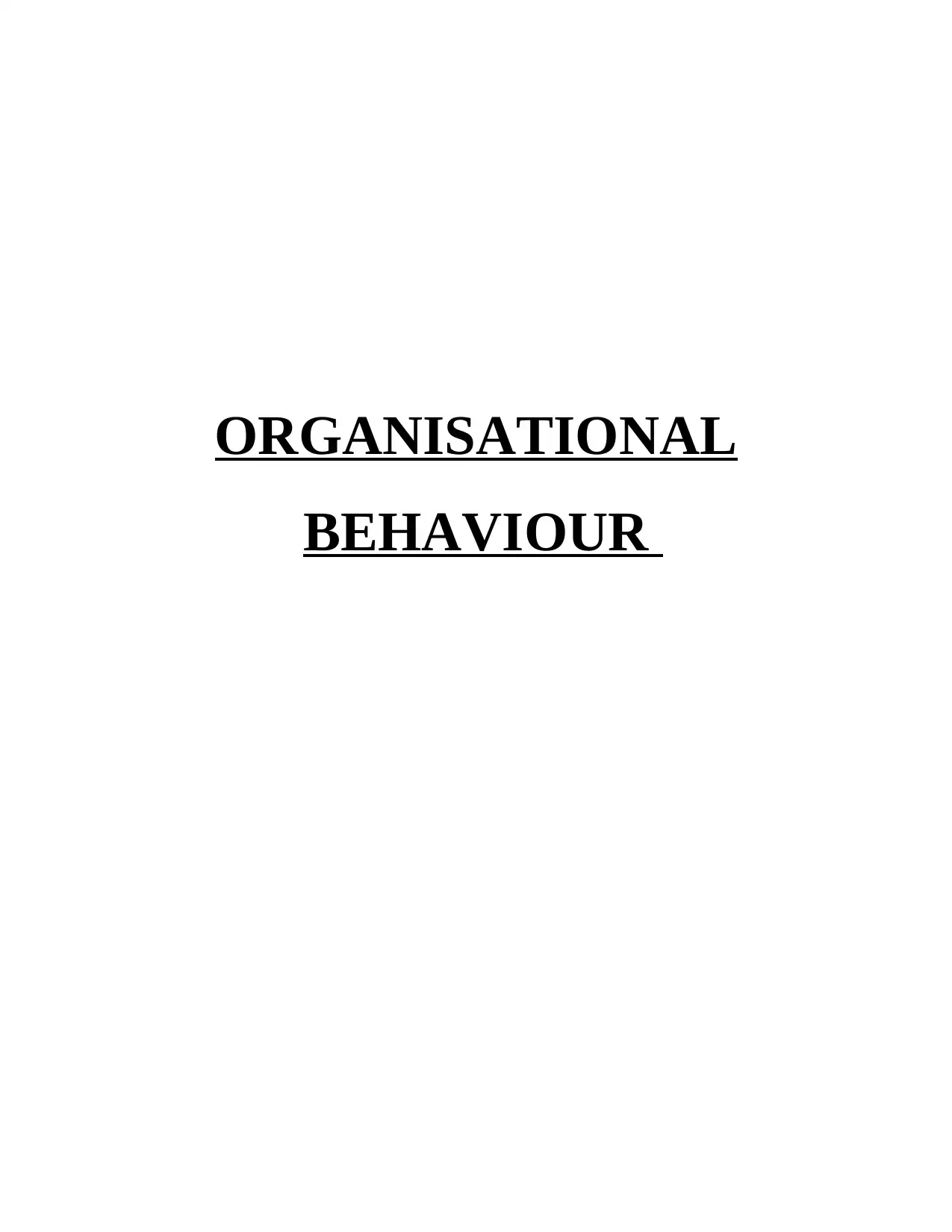
ORGANISATIONAL
BEHAVIOUR
BEHAVIOUR
Paraphrase This Document
Need a fresh take? Get an instant paraphrase of this document with our AI Paraphraser
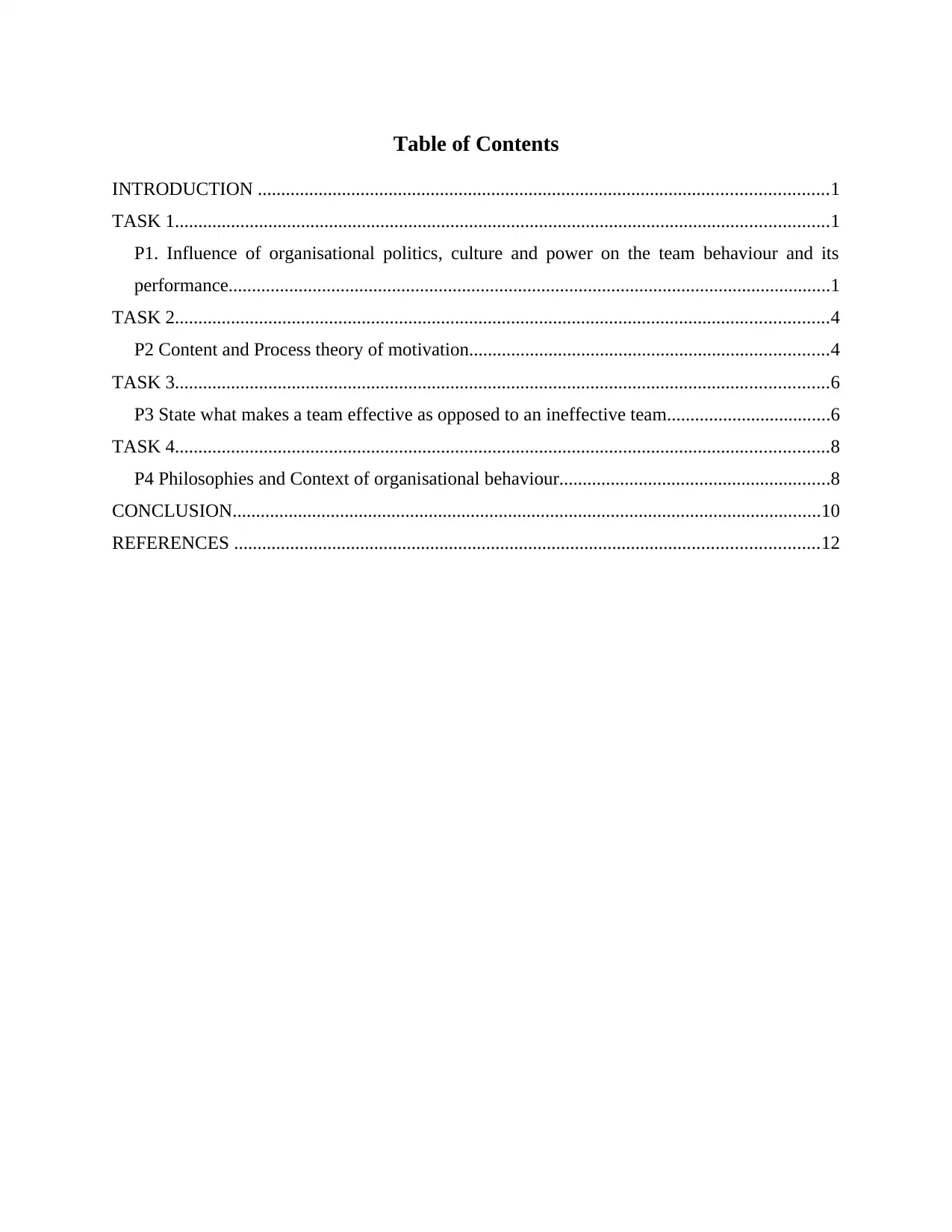
Table of Contents
INTRODUCTION ..........................................................................................................................1
TASK 1............................................................................................................................................1
P1. Influence of organisational politics, culture and power on the team behaviour and its
performance.................................................................................................................................1
TASK 2............................................................................................................................................4
P2 Content and Process theory of motivation.............................................................................4
TASK 3............................................................................................................................................6
P3 State what makes a team effective as opposed to an ineffective team...................................6
TASK 4............................................................................................................................................8
P4 Philosophies and Context of organisational behaviour..........................................................8
CONCLUSION..............................................................................................................................10
REFERENCES .............................................................................................................................12
INTRODUCTION ..........................................................................................................................1
TASK 1............................................................................................................................................1
P1. Influence of organisational politics, culture and power on the team behaviour and its
performance.................................................................................................................................1
TASK 2............................................................................................................................................4
P2 Content and Process theory of motivation.............................................................................4
TASK 3............................................................................................................................................6
P3 State what makes a team effective as opposed to an ineffective team...................................6
TASK 4............................................................................................................................................8
P4 Philosophies and Context of organisational behaviour..........................................................8
CONCLUSION..............................................................................................................................10
REFERENCES .............................................................................................................................12

⊘ This is a preview!⊘
Do you want full access?
Subscribe today to unlock all pages.

Trusted by 1+ million students worldwide
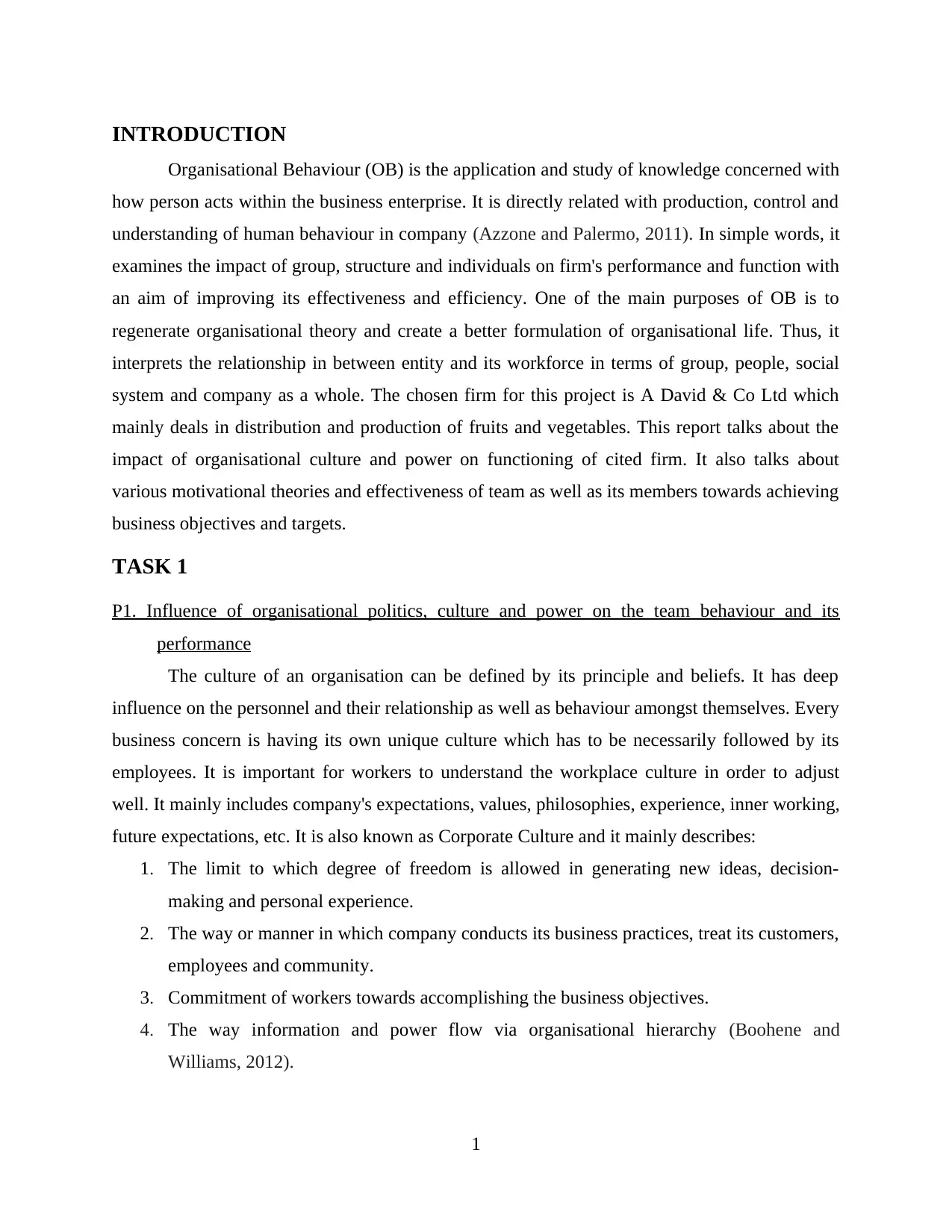
INTRODUCTION
Organisational Behaviour (OB) is the application and study of knowledge concerned with
how person acts within the business enterprise. It is directly related with production, control and
understanding of human behaviour in company (Azzone and Palermo, 2011). In simple words, it
examines the impact of group, structure and individuals on firm's performance and function with
an aim of improving its effectiveness and efficiency. One of the main purposes of OB is to
regenerate organisational theory and create a better formulation of organisational life. Thus, it
interprets the relationship in between entity and its workforce in terms of group, people, social
system and company as a whole. The chosen firm for this project is A David & Co Ltd which
mainly deals in distribution and production of fruits and vegetables. This report talks about the
impact of organisational culture and power on functioning of cited firm. It also talks about
various motivational theories and effectiveness of team as well as its members towards achieving
business objectives and targets.
TASK 1
P1. Influence of organisational politics, culture and power on the team behaviour and its
performance
The culture of an organisation can be defined by its principle and beliefs. It has deep
influence on the personnel and their relationship as well as behaviour amongst themselves. Every
business concern is having its own unique culture which has to be necessarily followed by its
employees. It is important for workers to understand the workplace culture in order to adjust
well. It mainly includes company's expectations, values, philosophies, experience, inner working,
future expectations, etc. It is also known as Corporate Culture and it mainly describes:
1. The limit to which degree of freedom is allowed in generating new ideas, decision-
making and personal experience.
2. The way or manner in which company conducts its business practices, treat its customers,
employees and community.
3. Commitment of workers towards accomplishing the business objectives.
4. The way information and power flow via organisational hierarchy (Boohene and
Williams, 2012).
1
Organisational Behaviour (OB) is the application and study of knowledge concerned with
how person acts within the business enterprise. It is directly related with production, control and
understanding of human behaviour in company (Azzone and Palermo, 2011). In simple words, it
examines the impact of group, structure and individuals on firm's performance and function with
an aim of improving its effectiveness and efficiency. One of the main purposes of OB is to
regenerate organisational theory and create a better formulation of organisational life. Thus, it
interprets the relationship in between entity and its workforce in terms of group, people, social
system and company as a whole. The chosen firm for this project is A David & Co Ltd which
mainly deals in distribution and production of fruits and vegetables. This report talks about the
impact of organisational culture and power on functioning of cited firm. It also talks about
various motivational theories and effectiveness of team as well as its members towards achieving
business objectives and targets.
TASK 1
P1. Influence of organisational politics, culture and power on the team behaviour and its
performance
The culture of an organisation can be defined by its principle and beliefs. It has deep
influence on the personnel and their relationship as well as behaviour amongst themselves. Every
business concern is having its own unique culture which has to be necessarily followed by its
employees. It is important for workers to understand the workplace culture in order to adjust
well. It mainly includes company's expectations, values, philosophies, experience, inner working,
future expectations, etc. It is also known as Corporate Culture and it mainly describes:
1. The limit to which degree of freedom is allowed in generating new ideas, decision-
making and personal experience.
2. The way or manner in which company conducts its business practices, treat its customers,
employees and community.
3. Commitment of workers towards accomplishing the business objectives.
4. The way information and power flow via organisational hierarchy (Boohene and
Williams, 2012).
1
Paraphrase This Document
Need a fresh take? Get an instant paraphrase of this document with our AI Paraphraser
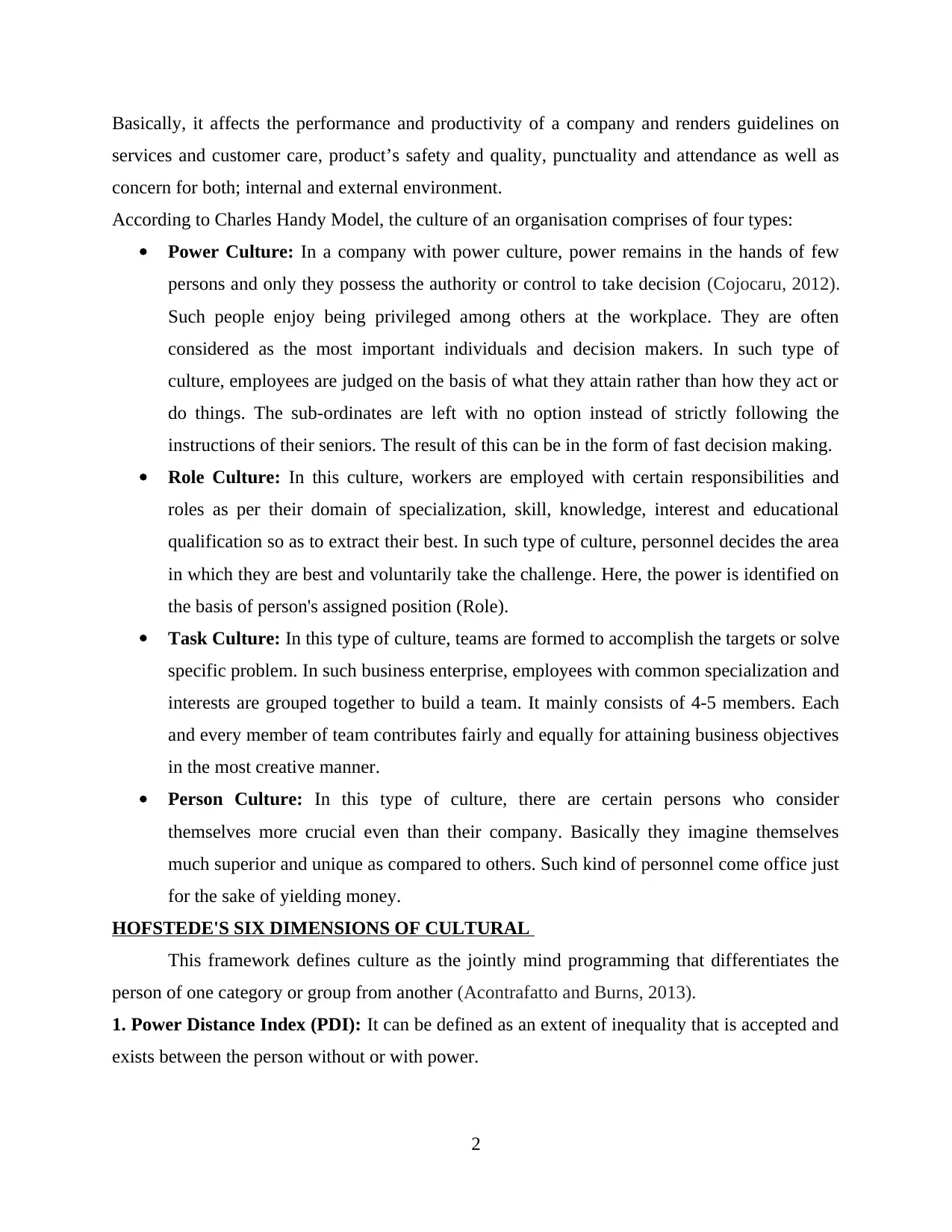
Basically, it affects the performance and productivity of a company and renders guidelines on
services and customer care, product’s safety and quality, punctuality and attendance as well as
concern for both; internal and external environment.
According to Charles Handy Model, the culture of an organisation comprises of four types:
Power Culture: In a company with power culture, power remains in the hands of few
persons and only they possess the authority or control to take decision (Cojocaru, 2012).
Such people enjoy being privileged among others at the workplace. They are often
considered as the most important individuals and decision makers. In such type of
culture, employees are judged on the basis of what they attain rather than how they act or
do things. The sub-ordinates are left with no option instead of strictly following the
instructions of their seniors. The result of this can be in the form of fast decision making.
Role Culture: In this culture, workers are employed with certain responsibilities and
roles as per their domain of specialization, skill, knowledge, interest and educational
qualification so as to extract their best. In such type of culture, personnel decides the area
in which they are best and voluntarily take the challenge. Here, the power is identified on
the basis of person's assigned position (Role).
Task Culture: In this type of culture, teams are formed to accomplish the targets or solve
specific problem. In such business enterprise, employees with common specialization and
interests are grouped together to build a team. It mainly consists of 4-5 members. Each
and every member of team contributes fairly and equally for attaining business objectives
in the most creative manner.
Person Culture: In this type of culture, there are certain persons who consider
themselves more crucial even than their company. Basically they imagine themselves
much superior and unique as compared to others. Such kind of personnel come office just
for the sake of yielding money.
HOFSTEDE'S SIX DIMENSIONS OF CULTURAL
This framework defines culture as the jointly mind programming that differentiates the
person of one category or group from another (Acontrafatto and Burns, 2013).
1. Power Distance Index (PDI): It can be defined as an extent of inequality that is accepted and
exists between the person without or with power.
2
services and customer care, product’s safety and quality, punctuality and attendance as well as
concern for both; internal and external environment.
According to Charles Handy Model, the culture of an organisation comprises of four types:
Power Culture: In a company with power culture, power remains in the hands of few
persons and only they possess the authority or control to take decision (Cojocaru, 2012).
Such people enjoy being privileged among others at the workplace. They are often
considered as the most important individuals and decision makers. In such type of
culture, employees are judged on the basis of what they attain rather than how they act or
do things. The sub-ordinates are left with no option instead of strictly following the
instructions of their seniors. The result of this can be in the form of fast decision making.
Role Culture: In this culture, workers are employed with certain responsibilities and
roles as per their domain of specialization, skill, knowledge, interest and educational
qualification so as to extract their best. In such type of culture, personnel decides the area
in which they are best and voluntarily take the challenge. Here, the power is identified on
the basis of person's assigned position (Role).
Task Culture: In this type of culture, teams are formed to accomplish the targets or solve
specific problem. In such business enterprise, employees with common specialization and
interests are grouped together to build a team. It mainly consists of 4-5 members. Each
and every member of team contributes fairly and equally for attaining business objectives
in the most creative manner.
Person Culture: In this type of culture, there are certain persons who consider
themselves more crucial even than their company. Basically they imagine themselves
much superior and unique as compared to others. Such kind of personnel come office just
for the sake of yielding money.
HOFSTEDE'S SIX DIMENSIONS OF CULTURAL
This framework defines culture as the jointly mind programming that differentiates the
person of one category or group from another (Acontrafatto and Burns, 2013).
1. Power Distance Index (PDI): It can be defined as an extent of inequality that is accepted and
exists between the person without or with power.
2
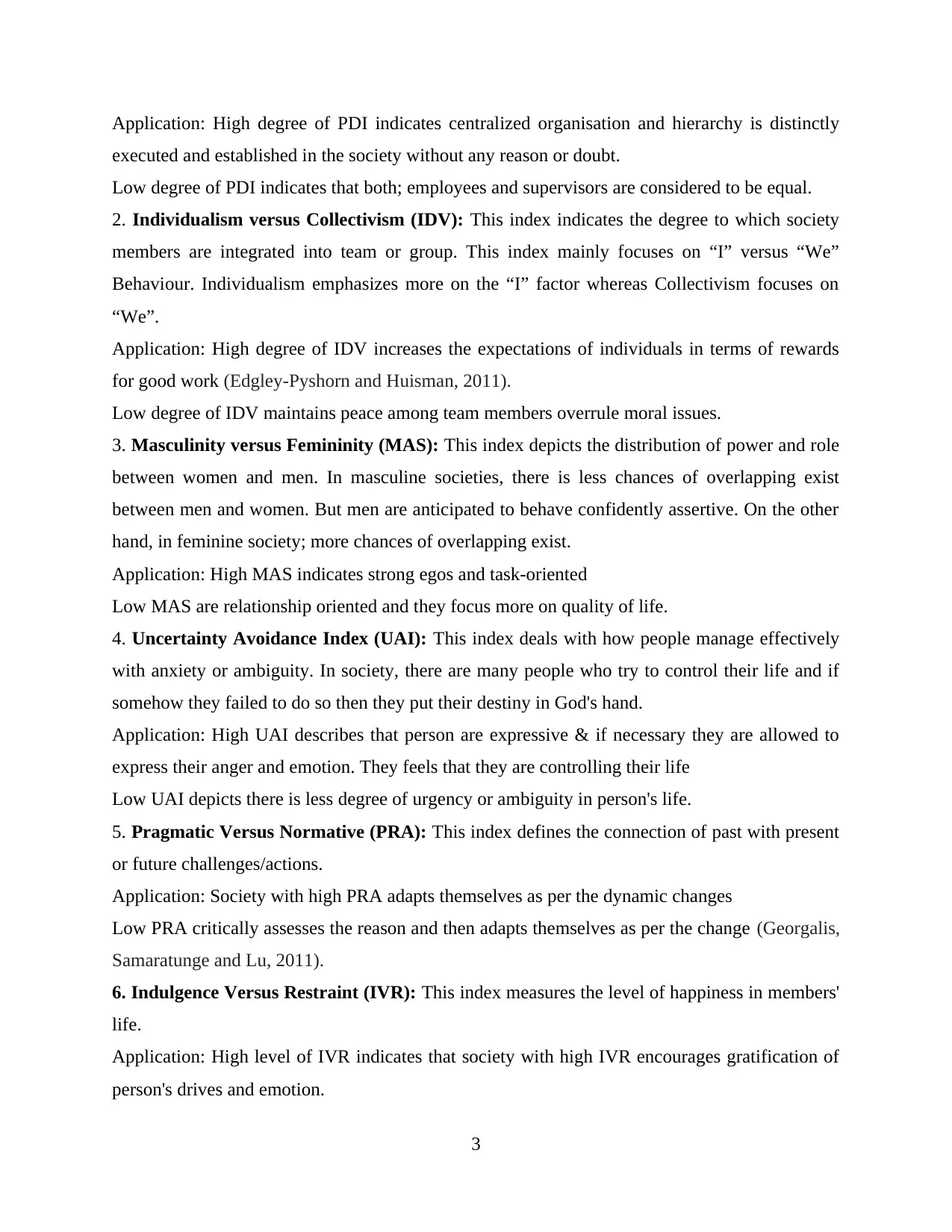
Application: High degree of PDI indicates centralized organisation and hierarchy is distinctly
executed and established in the society without any reason or doubt.
Low degree of PDI indicates that both; employees and supervisors are considered to be equal.
2. Individualism versus Collectivism (IDV): This index indicates the degree to which society
members are integrated into team or group. This index mainly focuses on “I” versus “We”
Behaviour. Individualism emphasizes more on the “I” factor whereas Collectivism focuses on
“We”.
Application: High degree of IDV increases the expectations of individuals in terms of rewards
for good work (Edgley-Pyshorn and Huisman, 2011).
Low degree of IDV maintains peace among team members overrule moral issues.
3. Masculinity versus Femininity (MAS): This index depicts the distribution of power and role
between women and men. In masculine societies, there is less chances of overlapping exist
between men and women. But men are anticipated to behave confidently assertive. On the other
hand, in feminine society; more chances of overlapping exist.
Application: High MAS indicates strong egos and task-oriented
Low MAS are relationship oriented and they focus more on quality of life.
4. Uncertainty Avoidance Index (UAI): This index deals with how people manage effectively
with anxiety or ambiguity. In society, there are many people who try to control their life and if
somehow they failed to do so then they put their destiny in God's hand.
Application: High UAI describes that person are expressive & if necessary they are allowed to
express their anger and emotion. They feels that they are controlling their life
Low UAI depicts there is less degree of urgency or ambiguity in person's life.
5. Pragmatic Versus Normative (PRA): This index defines the connection of past with present
or future challenges/actions.
Application: Society with high PRA adapts themselves as per the dynamic changes
Low PRA critically assesses the reason and then adapts themselves as per the change (Georgalis,
Samaratunge and Lu, 2011).
6. Indulgence Versus Restraint (IVR): This index measures the level of happiness in members'
life.
Application: High level of IVR indicates that society with high IVR encourages gratification of
person's drives and emotion.
3
executed and established in the society without any reason or doubt.
Low degree of PDI indicates that both; employees and supervisors are considered to be equal.
2. Individualism versus Collectivism (IDV): This index indicates the degree to which society
members are integrated into team or group. This index mainly focuses on “I” versus “We”
Behaviour. Individualism emphasizes more on the “I” factor whereas Collectivism focuses on
“We”.
Application: High degree of IDV increases the expectations of individuals in terms of rewards
for good work (Edgley-Pyshorn and Huisman, 2011).
Low degree of IDV maintains peace among team members overrule moral issues.
3. Masculinity versus Femininity (MAS): This index depicts the distribution of power and role
between women and men. In masculine societies, there is less chances of overlapping exist
between men and women. But men are anticipated to behave confidently assertive. On the other
hand, in feminine society; more chances of overlapping exist.
Application: High MAS indicates strong egos and task-oriented
Low MAS are relationship oriented and they focus more on quality of life.
4. Uncertainty Avoidance Index (UAI): This index deals with how people manage effectively
with anxiety or ambiguity. In society, there are many people who try to control their life and if
somehow they failed to do so then they put their destiny in God's hand.
Application: High UAI describes that person are expressive & if necessary they are allowed to
express their anger and emotion. They feels that they are controlling their life
Low UAI depicts there is less degree of urgency or ambiguity in person's life.
5. Pragmatic Versus Normative (PRA): This index defines the connection of past with present
or future challenges/actions.
Application: Society with high PRA adapts themselves as per the dynamic changes
Low PRA critically assesses the reason and then adapts themselves as per the change (Georgalis,
Samaratunge and Lu, 2011).
6. Indulgence Versus Restraint (IVR): This index measures the level of happiness in members'
life.
Application: High level of IVR indicates that society with high IVR encourages gratification of
person's drives and emotion.
3
⊘ This is a preview!⊘
Do you want full access?
Subscribe today to unlock all pages.

Trusted by 1+ million students worldwide
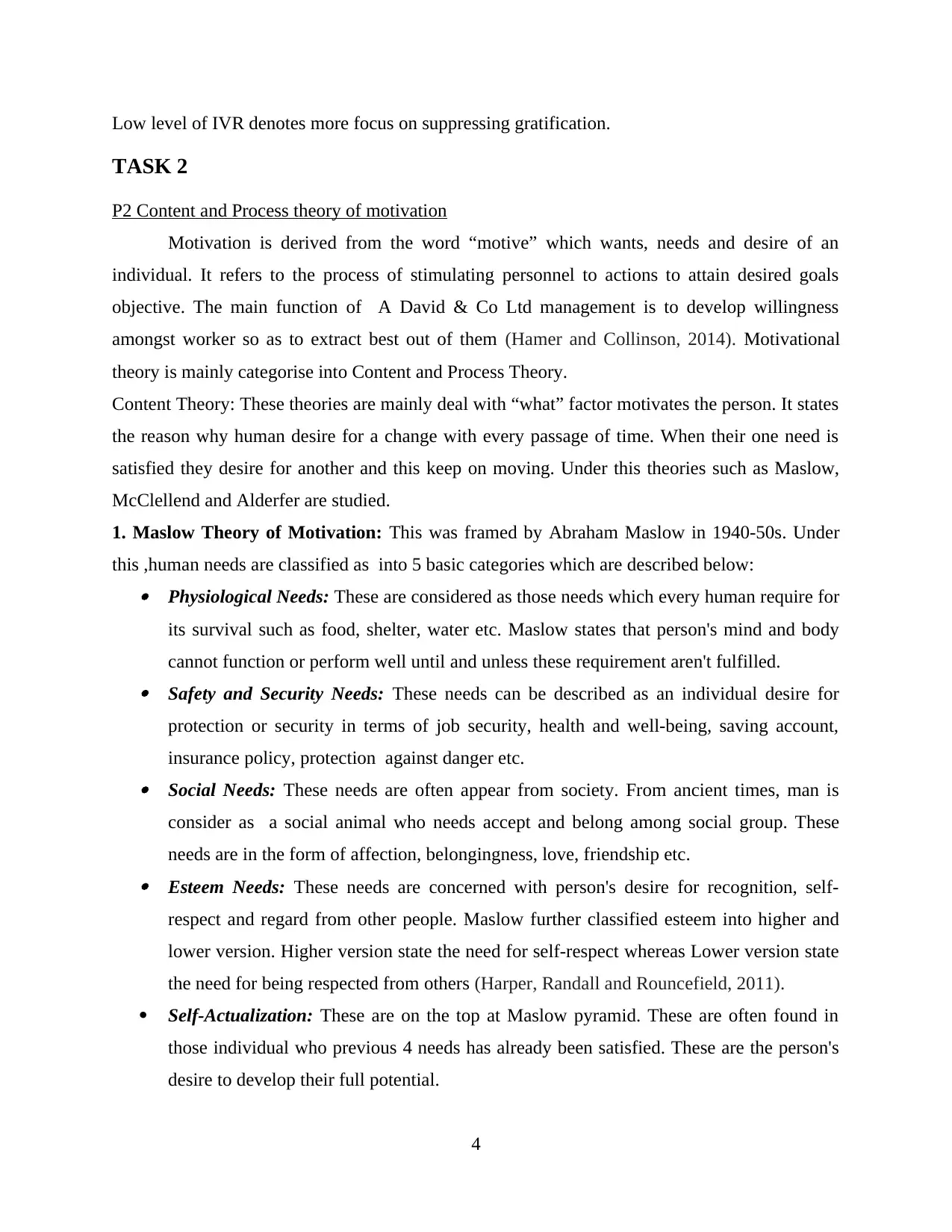
Low level of IVR denotes more focus on suppressing gratification.
TASK 2
P2 Content and Process theory of motivation
Motivation is derived from the word “motive” which wants, needs and desire of an
individual. It refers to the process of stimulating personnel to actions to attain desired goals
objective. The main function of A David & Co Ltd management is to develop willingness
amongst worker so as to extract best out of them (Hamer and Collinson, 2014). Motivational
theory is mainly categorise into Content and Process Theory.
Content Theory: These theories are mainly deal with “what” factor motivates the person. It states
the reason why human desire for a change with every passage of time. When their one need is
satisfied they desire for another and this keep on moving. Under this theories such as Maslow,
McClellend and Alderfer are studied.
1. Maslow Theory of Motivation: This was framed by Abraham Maslow in 1940-50s. Under
this ,human needs are classified as into 5 basic categories which are described below: Physiological Needs: These are considered as those needs which every human require for
its survival such as food, shelter, water etc. Maslow states that person's mind and body
cannot function or perform well until and unless these requirement aren't fulfilled. Safety and Security Needs: These needs can be described as an individual desire for
protection or security in terms of job security, health and well-being, saving account,
insurance policy, protection against danger etc. Social Needs: These needs are often appear from society. From ancient times, man is
consider as a social animal who needs accept and belong among social group. These
needs are in the form of affection, belongingness, love, friendship etc. Esteem Needs: These needs are concerned with person's desire for recognition, self-
respect and regard from other people. Maslow further classified esteem into higher and
lower version. Higher version state the need for self-respect whereas Lower version state
the need for being respected from others (Harper, Randall and Rouncefield, 2011).
Self-Actualization: These are on the top at Maslow pyramid. These are often found in
those individual who previous 4 needs has already been satisfied. These are the person's
desire to develop their full potential.
4
TASK 2
P2 Content and Process theory of motivation
Motivation is derived from the word “motive” which wants, needs and desire of an
individual. It refers to the process of stimulating personnel to actions to attain desired goals
objective. The main function of A David & Co Ltd management is to develop willingness
amongst worker so as to extract best out of them (Hamer and Collinson, 2014). Motivational
theory is mainly categorise into Content and Process Theory.
Content Theory: These theories are mainly deal with “what” factor motivates the person. It states
the reason why human desire for a change with every passage of time. When their one need is
satisfied they desire for another and this keep on moving. Under this theories such as Maslow,
McClellend and Alderfer are studied.
1. Maslow Theory of Motivation: This was framed by Abraham Maslow in 1940-50s. Under
this ,human needs are classified as into 5 basic categories which are described below: Physiological Needs: These are considered as those needs which every human require for
its survival such as food, shelter, water etc. Maslow states that person's mind and body
cannot function or perform well until and unless these requirement aren't fulfilled. Safety and Security Needs: These needs can be described as an individual desire for
protection or security in terms of job security, health and well-being, saving account,
insurance policy, protection against danger etc. Social Needs: These needs are often appear from society. From ancient times, man is
consider as a social animal who needs accept and belong among social group. These
needs are in the form of affection, belongingness, love, friendship etc. Esteem Needs: These needs are concerned with person's desire for recognition, self-
respect and regard from other people. Maslow further classified esteem into higher and
lower version. Higher version state the need for self-respect whereas Lower version state
the need for being respected from others (Harper, Randall and Rouncefield, 2011).
Self-Actualization: These are on the top at Maslow pyramid. These are often found in
those individual who previous 4 needs has already been satisfied. These are the person's
desire to develop their full potential.
4
Paraphrase This Document
Need a fresh take? Get an instant paraphrase of this document with our AI Paraphraser
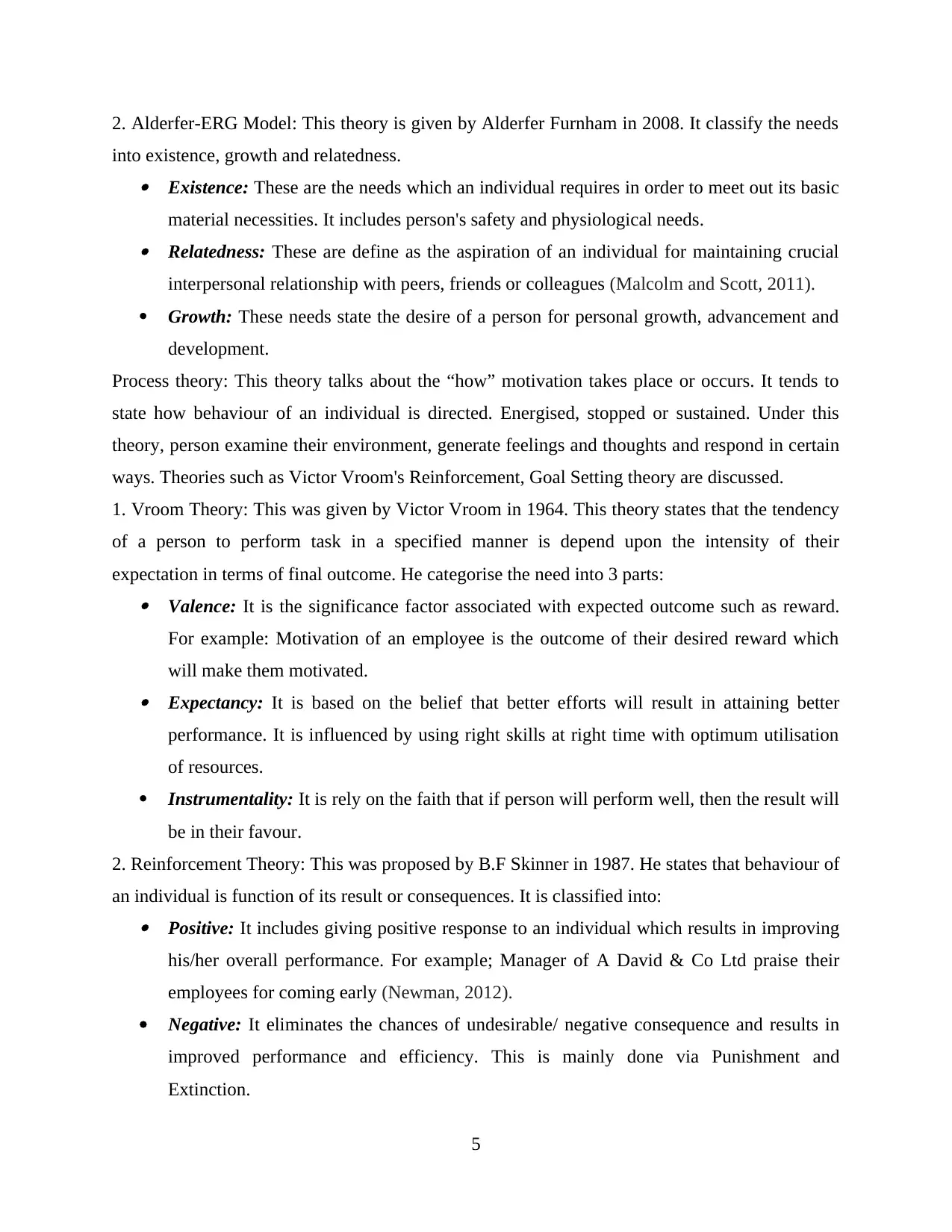
2. Alderfer-ERG Model: This theory is given by Alderfer Furnham in 2008. It classify the needs
into existence, growth and relatedness. Existence: These are the needs which an individual requires in order to meet out its basic
material necessities. It includes person's safety and physiological needs. Relatedness: These are define as the aspiration of an individual for maintaining crucial
interpersonal relationship with peers, friends or colleagues (Malcolm and Scott, 2011).
Growth: These needs state the desire of a person for personal growth, advancement and
development.
Process theory: This theory talks about the “how” motivation takes place or occurs. It tends to
state how behaviour of an individual is directed. Energised, stopped or sustained. Under this
theory, person examine their environment, generate feelings and thoughts and respond in certain
ways. Theories such as Victor Vroom's Reinforcement, Goal Setting theory are discussed.
1. Vroom Theory: This was given by Victor Vroom in 1964. This theory states that the tendency
of a person to perform task in a specified manner is depend upon the intensity of their
expectation in terms of final outcome. He categorise the need into 3 parts: Valence: It is the significance factor associated with expected outcome such as reward.
For example: Motivation of an employee is the outcome of their desired reward which
will make them motivated. Expectancy: It is based on the belief that better efforts will result in attaining better
performance. It is influenced by using right skills at right time with optimum utilisation
of resources.
Instrumentality: It is rely on the faith that if person will perform well, then the result will
be in their favour.
2. Reinforcement Theory: This was proposed by B.F Skinner in 1987. He states that behaviour of
an individual is function of its result or consequences. It is classified into: Positive: It includes giving positive response to an individual which results in improving
his/her overall performance. For example; Manager of A David & Co Ltd praise their
employees for coming early (Newman, 2012).
Negative: It eliminates the chances of undesirable/ negative consequence and results in
improved performance and efficiency. This is mainly done via Punishment and
Extinction.
5
into existence, growth and relatedness. Existence: These are the needs which an individual requires in order to meet out its basic
material necessities. It includes person's safety and physiological needs. Relatedness: These are define as the aspiration of an individual for maintaining crucial
interpersonal relationship with peers, friends or colleagues (Malcolm and Scott, 2011).
Growth: These needs state the desire of a person for personal growth, advancement and
development.
Process theory: This theory talks about the “how” motivation takes place or occurs. It tends to
state how behaviour of an individual is directed. Energised, stopped or sustained. Under this
theory, person examine their environment, generate feelings and thoughts and respond in certain
ways. Theories such as Victor Vroom's Reinforcement, Goal Setting theory are discussed.
1. Vroom Theory: This was given by Victor Vroom in 1964. This theory states that the tendency
of a person to perform task in a specified manner is depend upon the intensity of their
expectation in terms of final outcome. He categorise the need into 3 parts: Valence: It is the significance factor associated with expected outcome such as reward.
For example: Motivation of an employee is the outcome of their desired reward which
will make them motivated. Expectancy: It is based on the belief that better efforts will result in attaining better
performance. It is influenced by using right skills at right time with optimum utilisation
of resources.
Instrumentality: It is rely on the faith that if person will perform well, then the result will
be in their favour.
2. Reinforcement Theory: This was proposed by B.F Skinner in 1987. He states that behaviour of
an individual is function of its result or consequences. It is classified into: Positive: It includes giving positive response to an individual which results in improving
his/her overall performance. For example; Manager of A David & Co Ltd praise their
employees for coming early (Newman, 2012).
Negative: It eliminates the chances of undesirable/ negative consequence and results in
improved performance and efficiency. This is mainly done via Punishment and
Extinction.
5
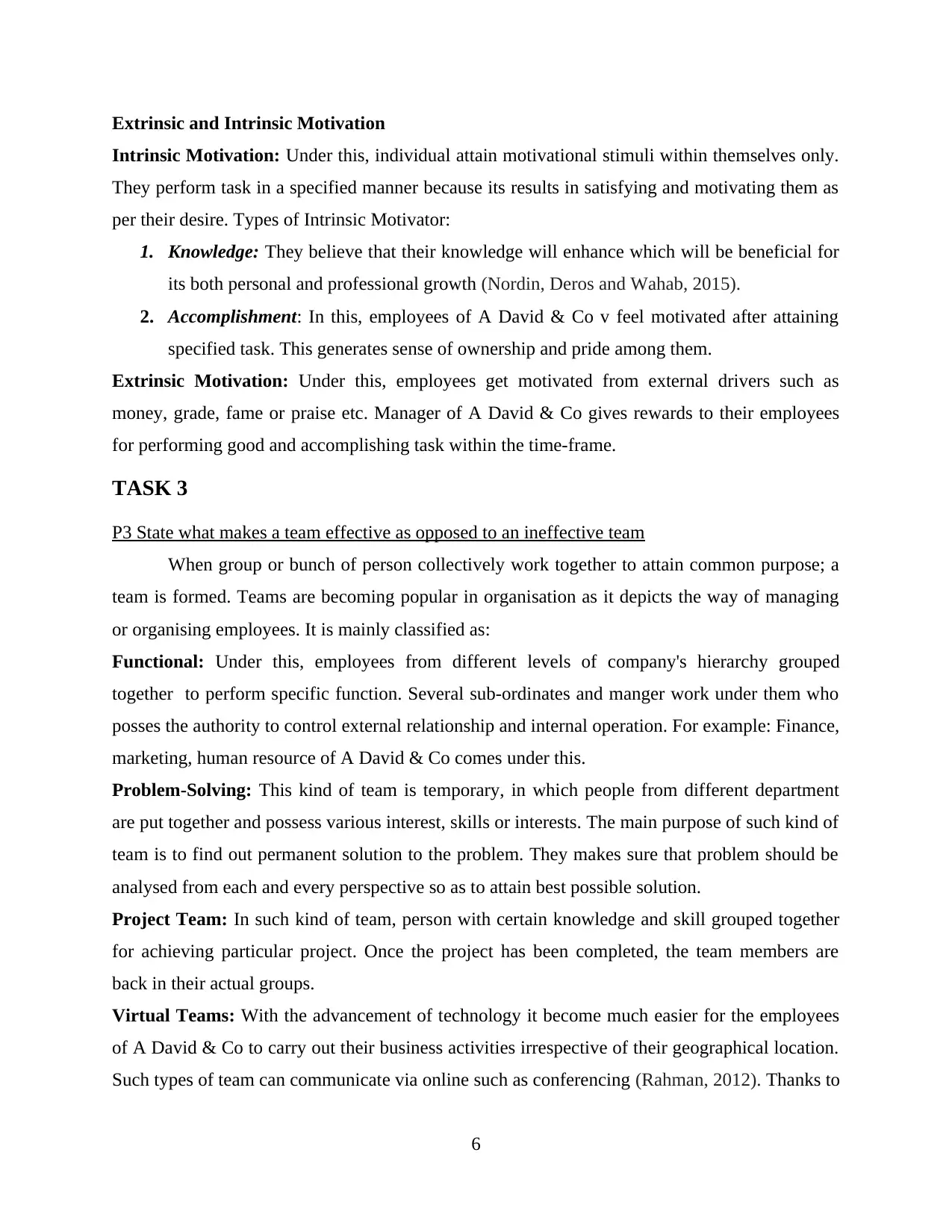
Extrinsic and Intrinsic Motivation
Intrinsic Motivation: Under this, individual attain motivational stimuli within themselves only.
They perform task in a specified manner because its results in satisfying and motivating them as
per their desire. Types of Intrinsic Motivator:
1. Knowledge: They believe that their knowledge will enhance which will be beneficial for
its both personal and professional growth (Nordin, Deros and Wahab, 2015).
2. Accomplishment: In this, employees of A David & Co v feel motivated after attaining
specified task. This generates sense of ownership and pride among them.
Extrinsic Motivation: Under this, employees get motivated from external drivers such as
money, grade, fame or praise etc. Manager of A David & Co gives rewards to their employees
for performing good and accomplishing task within the time-frame.
TASK 3
P3 State what makes a team effective as opposed to an ineffective team
When group or bunch of person collectively work together to attain common purpose; a
team is formed. Teams are becoming popular in organisation as it depicts the way of managing
or organising employees. It is mainly classified as:
Functional: Under this, employees from different levels of company's hierarchy grouped
together to perform specific function. Several sub-ordinates and manger work under them who
posses the authority to control external relationship and internal operation. For example: Finance,
marketing, human resource of A David & Co comes under this.
Problem-Solving: This kind of team is temporary, in which people from different department
are put together and possess various interest, skills or interests. The main purpose of such kind of
team is to find out permanent solution to the problem. They makes sure that problem should be
analysed from each and every perspective so as to attain best possible solution.
Project Team: In such kind of team, person with certain knowledge and skill grouped together
for achieving particular project. Once the project has been completed, the team members are
back in their actual groups.
Virtual Teams: With the advancement of technology it become much easier for the employees
of A David & Co to carry out their business activities irrespective of their geographical location.
Such types of team can communicate via online such as conferencing (Rahman, 2012). Thanks to
6
Intrinsic Motivation: Under this, individual attain motivational stimuli within themselves only.
They perform task in a specified manner because its results in satisfying and motivating them as
per their desire. Types of Intrinsic Motivator:
1. Knowledge: They believe that their knowledge will enhance which will be beneficial for
its both personal and professional growth (Nordin, Deros and Wahab, 2015).
2. Accomplishment: In this, employees of A David & Co v feel motivated after attaining
specified task. This generates sense of ownership and pride among them.
Extrinsic Motivation: Under this, employees get motivated from external drivers such as
money, grade, fame or praise etc. Manager of A David & Co gives rewards to their employees
for performing good and accomplishing task within the time-frame.
TASK 3
P3 State what makes a team effective as opposed to an ineffective team
When group or bunch of person collectively work together to attain common purpose; a
team is formed. Teams are becoming popular in organisation as it depicts the way of managing
or organising employees. It is mainly classified as:
Functional: Under this, employees from different levels of company's hierarchy grouped
together to perform specific function. Several sub-ordinates and manger work under them who
posses the authority to control external relationship and internal operation. For example: Finance,
marketing, human resource of A David & Co comes under this.
Problem-Solving: This kind of team is temporary, in which people from different department
are put together and possess various interest, skills or interests. The main purpose of such kind of
team is to find out permanent solution to the problem. They makes sure that problem should be
analysed from each and every perspective so as to attain best possible solution.
Project Team: In such kind of team, person with certain knowledge and skill grouped together
for achieving particular project. Once the project has been completed, the team members are
back in their actual groups.
Virtual Teams: With the advancement of technology it become much easier for the employees
of A David & Co to carry out their business activities irrespective of their geographical location.
Such types of team can communicate via online such as conferencing (Rahman, 2012). Thanks to
6
⊘ This is a preview!⊘
Do you want full access?
Subscribe today to unlock all pages.

Trusted by 1+ million students worldwide
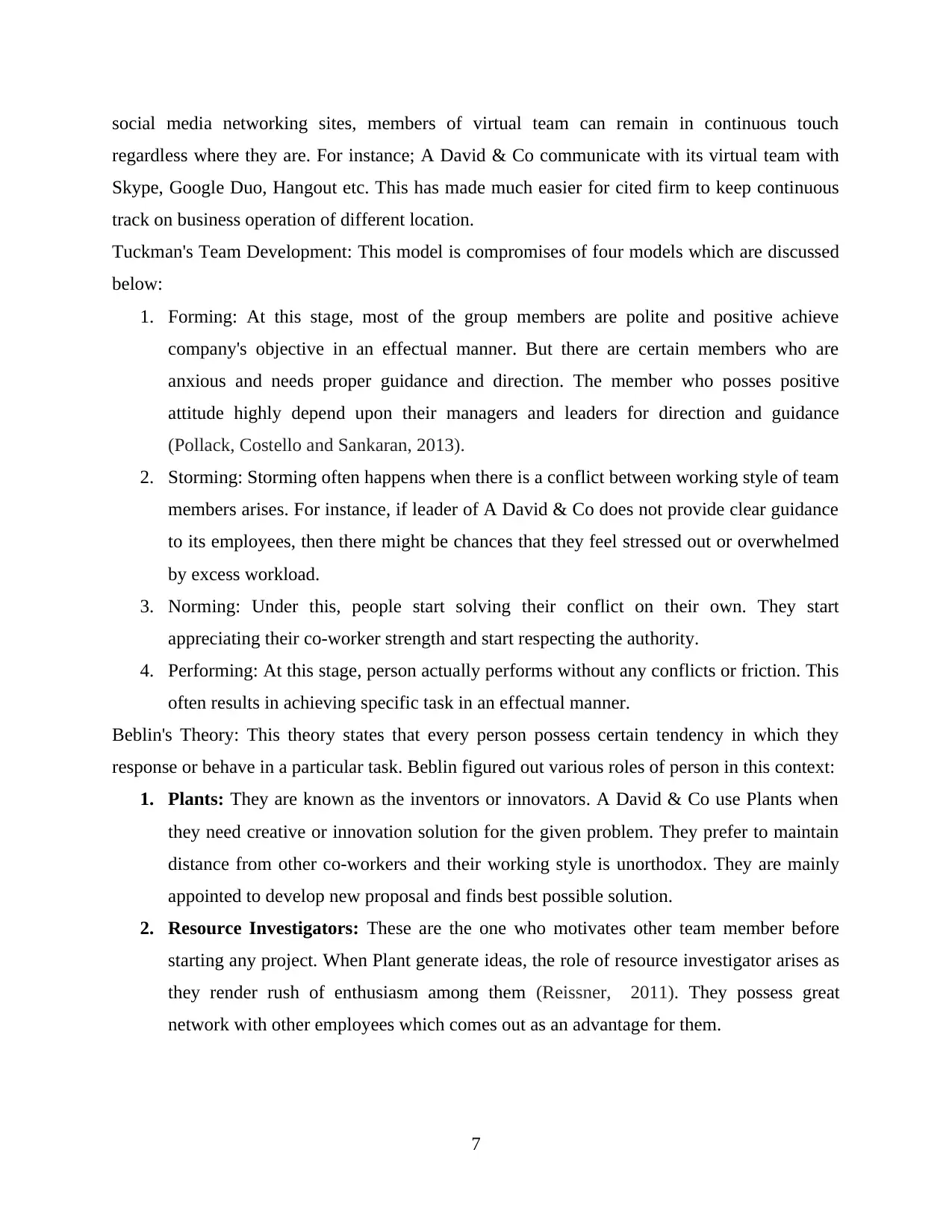
social media networking sites, members of virtual team can remain in continuous touch
regardless where they are. For instance; A David & Co communicate with its virtual team with
Skype, Google Duo, Hangout etc. This has made much easier for cited firm to keep continuous
track on business operation of different location.
Tuckman's Team Development: This model is compromises of four models which are discussed
below:
1. Forming: At this stage, most of the group members are polite and positive achieve
company's objective in an effectual manner. But there are certain members who are
anxious and needs proper guidance and direction. The member who posses positive
attitude highly depend upon their managers and leaders for direction and guidance
(Pollack, Costello and Sankaran, 2013).
2. Storming: Storming often happens when there is a conflict between working style of team
members arises. For instance, if leader of A David & Co does not provide clear guidance
to its employees, then there might be chances that they feel stressed out or overwhelmed
by excess workload.
3. Norming: Under this, people start solving their conflict on their own. They start
appreciating their co-worker strength and start respecting the authority.
4. Performing: At this stage, person actually performs without any conflicts or friction. This
often results in achieving specific task in an effectual manner.
Beblin's Theory: This theory states that every person possess certain tendency in which they
response or behave in a particular task. Beblin figured out various roles of person in this context:
1. Plants: They are known as the inventors or innovators. A David & Co use Plants when
they need creative or innovation solution for the given problem. They prefer to maintain
distance from other co-workers and their working style is unorthodox. They are mainly
appointed to develop new proposal and finds best possible solution.
2. Resource Investigators: These are the one who motivates other team member before
starting any project. When Plant generate ideas, the role of resource investigator arises as
they render rush of enthusiasm among them (Reissner, 2011). They possess great
network with other employees which comes out as an advantage for them.
7
regardless where they are. For instance; A David & Co communicate with its virtual team with
Skype, Google Duo, Hangout etc. This has made much easier for cited firm to keep continuous
track on business operation of different location.
Tuckman's Team Development: This model is compromises of four models which are discussed
below:
1. Forming: At this stage, most of the group members are polite and positive achieve
company's objective in an effectual manner. But there are certain members who are
anxious and needs proper guidance and direction. The member who posses positive
attitude highly depend upon their managers and leaders for direction and guidance
(Pollack, Costello and Sankaran, 2013).
2. Storming: Storming often happens when there is a conflict between working style of team
members arises. For instance, if leader of A David & Co does not provide clear guidance
to its employees, then there might be chances that they feel stressed out or overwhelmed
by excess workload.
3. Norming: Under this, people start solving their conflict on their own. They start
appreciating their co-worker strength and start respecting the authority.
4. Performing: At this stage, person actually performs without any conflicts or friction. This
often results in achieving specific task in an effectual manner.
Beblin's Theory: This theory states that every person possess certain tendency in which they
response or behave in a particular task. Beblin figured out various roles of person in this context:
1. Plants: They are known as the inventors or innovators. A David & Co use Plants when
they need creative or innovation solution for the given problem. They prefer to maintain
distance from other co-workers and their working style is unorthodox. They are mainly
appointed to develop new proposal and finds best possible solution.
2. Resource Investigators: These are the one who motivates other team member before
starting any project. When Plant generate ideas, the role of resource investigator arises as
they render rush of enthusiasm among them (Reissner, 2011). They possess great
network with other employees which comes out as an advantage for them.
7
Paraphrase This Document
Need a fresh take? Get an instant paraphrase of this document with our AI Paraphraser
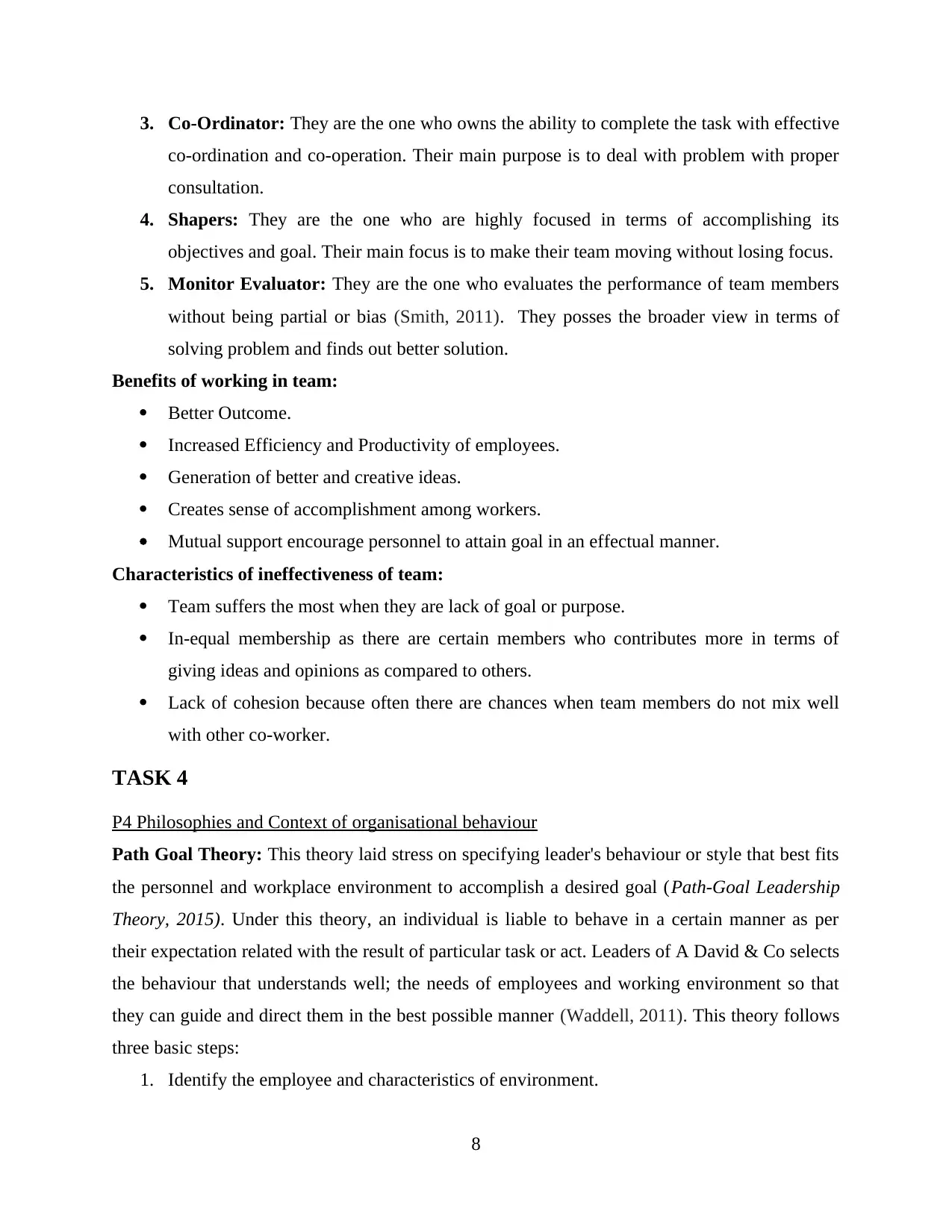
3. Co-Ordinator: They are the one who owns the ability to complete the task with effective
co-ordination and co-operation. Their main purpose is to deal with problem with proper
consultation.
4. Shapers: They are the one who are highly focused in terms of accomplishing its
objectives and goal. Their main focus is to make their team moving without losing focus.
5. Monitor Evaluator: They are the one who evaluates the performance of team members
without being partial or bias (Smith, 2011). They posses the broader view in terms of
solving problem and finds out better solution.
Benefits of working in team:
Better Outcome.
Increased Efficiency and Productivity of employees.
Generation of better and creative ideas.
Creates sense of accomplishment among workers.
Mutual support encourage personnel to attain goal in an effectual manner.
Characteristics of ineffectiveness of team:
Team suffers the most when they are lack of goal or purpose.
In-equal membership as there are certain members who contributes more in terms of
giving ideas and opinions as compared to others.
Lack of cohesion because often there are chances when team members do not mix well
with other co-worker.
TASK 4
P4 Philosophies and Context of organisational behaviour
Path Goal Theory: This theory laid stress on specifying leader's behaviour or style that best fits
the personnel and workplace environment to accomplish a desired goal (Path-Goal Leadership
Theory, 2015). Under this theory, an individual is liable to behave in a certain manner as per
their expectation related with the result of particular task or act. Leaders of A David & Co selects
the behaviour that understands well; the needs of employees and working environment so that
they can guide and direct them in the best possible manner (Waddell, 2011). This theory follows
three basic steps:
1. Identify the employee and characteristics of environment.
8
co-ordination and co-operation. Their main purpose is to deal with problem with proper
consultation.
4. Shapers: They are the one who are highly focused in terms of accomplishing its
objectives and goal. Their main focus is to make their team moving without losing focus.
5. Monitor Evaluator: They are the one who evaluates the performance of team members
without being partial or bias (Smith, 2011). They posses the broader view in terms of
solving problem and finds out better solution.
Benefits of working in team:
Better Outcome.
Increased Efficiency and Productivity of employees.
Generation of better and creative ideas.
Creates sense of accomplishment among workers.
Mutual support encourage personnel to attain goal in an effectual manner.
Characteristics of ineffectiveness of team:
Team suffers the most when they are lack of goal or purpose.
In-equal membership as there are certain members who contributes more in terms of
giving ideas and opinions as compared to others.
Lack of cohesion because often there are chances when team members do not mix well
with other co-worker.
TASK 4
P4 Philosophies and Context of organisational behaviour
Path Goal Theory: This theory laid stress on specifying leader's behaviour or style that best fits
the personnel and workplace environment to accomplish a desired goal (Path-Goal Leadership
Theory, 2015). Under this theory, an individual is liable to behave in a certain manner as per
their expectation related with the result of particular task or act. Leaders of A David & Co selects
the behaviour that understands well; the needs of employees and working environment so that
they can guide and direct them in the best possible manner (Waddell, 2011). This theory follows
three basic steps:
1. Identify the employee and characteristics of environment.
8
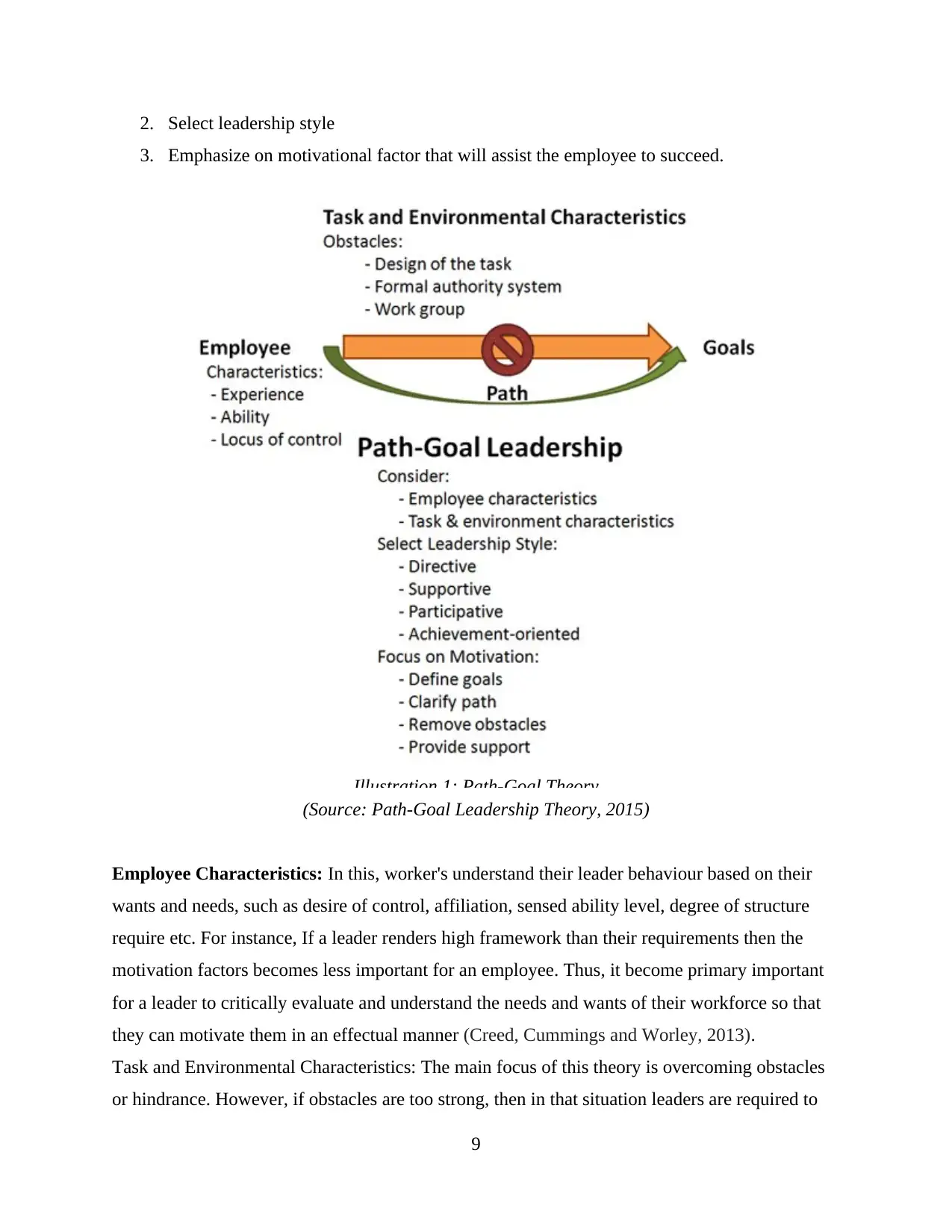
2. Select leadership style
3. Emphasize on motivational factor that will assist the employee to succeed.
(Source: Path-Goal Leadership Theory, 2015)
Employee Characteristics: In this, worker's understand their leader behaviour based on their
wants and needs, such as desire of control, affiliation, sensed ability level, degree of structure
require etc. For instance, If a leader renders high framework than their requirements then the
motivation factors becomes less important for an employee. Thus, it become primary important
for a leader to critically evaluate and understand the needs and wants of their workforce so that
they can motivate them in an effectual manner (Creed, Cummings and Worley, 2013).
Task and Environmental Characteristics: The main focus of this theory is overcoming obstacles
or hindrance. However, if obstacles are too strong, then in that situation leaders are required to
9
Illustration 1: Path-Goal Theory
3. Emphasize on motivational factor that will assist the employee to succeed.
(Source: Path-Goal Leadership Theory, 2015)
Employee Characteristics: In this, worker's understand their leader behaviour based on their
wants and needs, such as desire of control, affiliation, sensed ability level, degree of structure
require etc. For instance, If a leader renders high framework than their requirements then the
motivation factors becomes less important for an employee. Thus, it become primary important
for a leader to critically evaluate and understand the needs and wants of their workforce so that
they can motivate them in an effectual manner (Creed, Cummings and Worley, 2013).
Task and Environmental Characteristics: The main focus of this theory is overcoming obstacles
or hindrance. However, if obstacles are too strong, then in that situation leaders are required to
9
Illustration 1: Path-Goal Theory
⊘ This is a preview!⊘
Do you want full access?
Subscribe today to unlock all pages.

Trusted by 1+ million students worldwide
1 out of 15
Related Documents
Your All-in-One AI-Powered Toolkit for Academic Success.
+13062052269
info@desklib.com
Available 24*7 on WhatsApp / Email
![[object Object]](/_next/static/media/star-bottom.7253800d.svg)
Unlock your academic potential
Copyright © 2020–2025 A2Z Services. All Rights Reserved. Developed and managed by ZUCOL.




